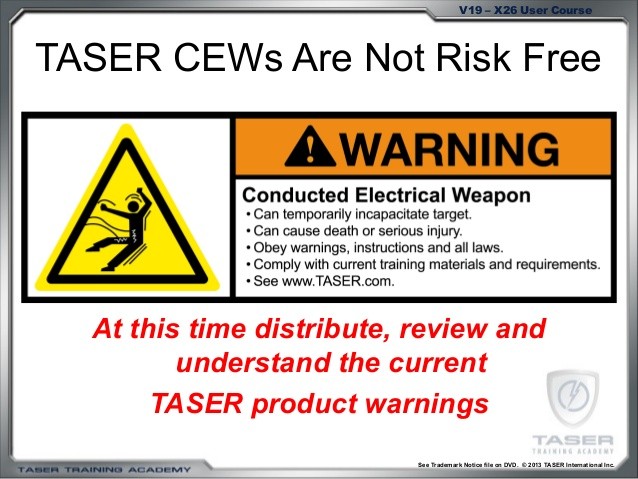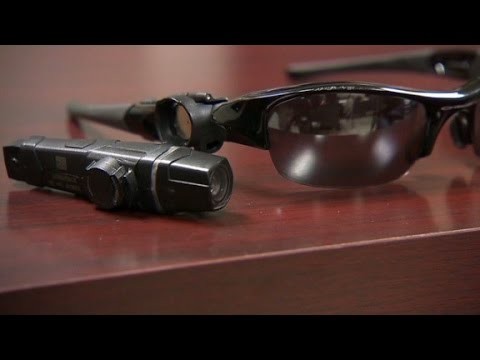Cautionary Signs For Taser s 4th Quarter TASER International Inc (NASDAQ TASR)
Post on: 21 Апрель, 2015 No Comment

Summary
- Obama’s $75 million, if approved by Congress, will not show up in Taser’s earnings any time soon.
- Budget and other constraints may stretch the body camera adoption process into years, not quarters.
- What powered Taser’s third quarter ahead may be winds out of its fourth quarter sails.
- Inside sales may indicate Taser management’s caution about fourth quarter performance.
Two thirds of Taser’s (NASDAQ:TASR ) fourth quarter is behind it and Taser’s share price has shot up like a rocket recently. It is thus the perfect time to take a closer look at some of the cautionary signs for Taser’s fourth quarter.
Not a Single Dollar of Obama’s 75 Million Will Be in Taser’s Fourth Quarter
The latest boost to Taser’s current rise in share price comes from Obama’s announcement that the federal government will spend $75 million to buy body cameras for police officers throughout the country. It is a reasonable expectation that many, if not most, of those dollars will end up buying Taser cameras, but if you know anything about federal funding, you know not one of those dollars will show up in Taser’s fourth quarter earnings.
First of all, those dollars are not Obama’s to give. He can only request that Congress provide the funding. When was the last time Congress willingly did Obama’s bidding? It will thus be unlikely for the lame duck 113th Congress to rush out that money before the curtain comes dawn on its notoriously deadlocked reign on January 3, 2015. Besides, Obama’s plan calls for that money to be spent in a three-year period anyway.
Secondly, even if Congress were somehow to get into the Santa spirit and approve the funding, it will take a long time to divvy up the funding among 18,000 policy agencies throughout the country. And the Obama funding is contingent on matching funds from cash-stretched local governments.
If anything, Obama’s proposal may even put some breaks on local governments’ momentum to fund body cameras. City councils may want to wait to see how much handout they can get before rushing into purchasing decisions.
Budget Constraints May Drag Out the Body Camera Adoption Process Into Years, Not Months, or Quarters
The Obama request does signify an important milestone: transparency in policing has officially crossed the threshold of outweighing privacy concerns. It has, at the same time, brought into sharper relief the reality of budget constraints.
The Obama plan calls for $75 million to equip 50,000 police officers. Even with matching funds from state governments, it only comes to $150 million. It will still fall far short of equipping 50,000 police officers.
The proposed funding seem to betray a woeful ignorance of how costly police body cameras really are. According to the Columbia, MO Police Department, via a report by KBIA. the Mid-Missouri Public Radio, for about 100 body cameras plus warranty, their one-time payment is $50,000 and the additional storage cost is $40,000 every year. If you extrapolate that to 50,000 police officers, the one-time payment would be $2.5 billion, and the annual storage cost would be $2 billion. Obama’s $75 million does not even amount to a drop in the bucket and should not have sent the Taser stock, let alone Digital Ally’s (NASDAQ:DGLY ) stock, straight up to the stratospheres.
It is true that the high cost of police body cameras may indicate a large potential revenue source for Taser but it also should remind any investor that the realization of this revenue may be a very long process. Another potential high cost for police body cameras has no discernible benefit for Taser at all.
Barely noticed by the investing public, the Seattle Police Department told the Seattle Times that they may scrap their planned body camera pilot program because crushing public records requests may cripple the city financially and tie up employees for countless hours. Even before the start of the pilot program, an anonymous citizen has already sent in requests to SPD for all footage and all other details of every 911 dispatches. That prompted calls for changes to public disclosure laws but even if those laws can be easily changed, the SPD concerns may put another brake onto the speedy adoption of body cameras nationwide.
What Gave Taser’s Third Quarter the Strong Push Forward May Have Been Steam Out of Its Fourth Quarter Engines

Another boost to Taser’s share price came from its record-shattering third quarter results. Yet, it is exactly the details of those results that should give investors pause about the strengths of its fourth quarter. Two thirds of Taser’s third quarter came after Ferguson, which ushered in a new era for police body cameras, but what gave Taser’s third quarter the strong jolt was not, in spite of wide expectations, body cameras but stun guns, especially the multi-million-dollar orders from two police agencies, Dallas and a federal agency.
As Taser’s CEO, Patrick Smith, and CFO, Daniel Behrendt, said in the third quarter results call, those orders are usually fourth quarter sales and were pushed forward to the third quarter. Both of them called these orders quarterly lumpiness. But what caused third quarter lumps naturally leads to fourth quarter dents.
Insider Sales May Indicate the Above Concerns Are Not Necessarily Mere Conjectures
Of course, Taser’s fourth quarter can create its own lumps. After all, year end is usually the time police agencies rush to spend the leftover budgetary dollars before the year runs out, and Taser’s fourth quarter is usually its strongest. But large insider sales do not seem to give this optimism much support.
In the one month since the announcement of strong third quarter results and into the share price pops as a result, Taser board and management members have filed nine sales reports with the SEC, more than the previous five months combined. Of particular significance are large sales by CFO Daniel Behrendt, 140,000 shares, and company president Douglas Klint, 170,000 shares, at prices between $18 and $20 per share. Most of those shares are employee stock options that are not going to expire until 2018 or 2020.
The rule of thumb for employee stock options is to hold them until right before expiration if the employees are confident of the company’s future and thus the rise of share price. Why would anybody want to forego a sure thing?
There are a few reasons for employees to sell their holdings. Let’s take a close look at those reasons, using CEO Daniel Behrendt’s first sales as an example.
On November 3, right after announcing strong third quarter results and into the price pop as a result, Behrendt sold 100,576 shares. 90,576 of those shares were employee options he just exercised. The striking prices for those options are $7.13 and $4.75 and he sold the acquired shares at $18.73 after market open on November 3. Those options will not expire until 2018. Behrendt followed that with sales of another 10,000 shares a little later at $19.24.
Behrendt might have needed the cash to cover the cost of exercising those options but he only needed to sell a few over 30,000 shares, not 90,000 shares, to cover the cost [(66,230×7.13+24,346×4.75)/18.73]. And that certainly cannot explain the selling of the extra 10,000 shares that he owned.
He might have wanted to lock in a low-cost basis for nonqualified options. This does not apply in Behrendt’s case because his options are qualified, as are most top management options, and the cost bases had already been determined at offering, in his case, $7.13 and $4.75.
He might have wanted to avoid being catapulted into a higher tax bracket by waiting. This may make sense except for the timing in Behrendt’s case. He has until year end to sell if he believed he is going to be in a higher tax bracket next year. Unless he believed share price has peaked until at least next year.
He might have lost confidence in the company. This is unlikely because Taser just had a record quarter and Behrendt and CEO Patrick Smith were very convincingly upbeat about the company’s mid-to-long term prospects in the third quarter results conference call. But they did talk about lumpiness in quarterly results. And they also said Ferguson impacts will not be fully felt until a couple of quarters down the road. They said these one month into the fourth quarter, which may indicate they are not that confident about the fourth quarter.
He may be overweight on company stock and want to diversify for safety. This is the reason Taser gave me in answering my question about their CEO Smith’s three large share sales in the past. Diversify for safety, this is indeed the financial industry mantra, but it only makes sense if you are concerned about the safety of your holdings. As Warren Buffett said, Diversification is protection against ignorance, it makes little sense for those who know what they’re doing. Behrendt is unlikely to be ignorant about Taser International; he is the company CFO.
In short, Taser’s share price may have risen way ahead of itself without much short-term support. With its P/E at that level and with so many cautionary signs about its fourth quarter performance, it may fall sharply with any trigger any time.
Disclosure: The author has no positions in any stocks mentioned, and no plans to initiate any positions within the next 72 hours. (More. ) The author wrote this article themselves, and it expresses their own opinions. The author is not receiving compensation for it (other than from Seeking Alpha). The author has no business relationship with any company whose stock is mentioned in this article.














